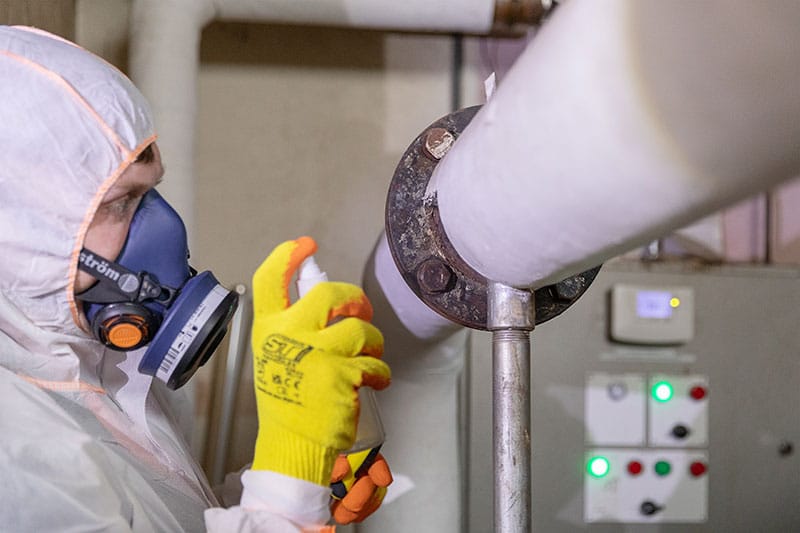What are the do’s and don’ts of working with asbestos safely?
The most serious health risks of asbestos exposure include:
- The chronic lung disease asbestosis
- Lung cancer, which can be worsened by smoking
- Mesothelioma, a rare type of cancer caused by asbestos exposure
- Inflammation of the lining of the lungs
These diseases typically have a long latency period, which means they can show up years after exposure occurs. Often, the required treatments are aggressive, and many of these diseases are life-threatening.
With the potential to cause such serious health issues, asbestos safety is of the utmost importance.

What professions have the highest risk of asbestos exposure?
While asbestos may be present in any building that was built prior to 2000, and it can also be found in cement, cars, and more, some professions have a higher risk of exposure than others. Those include:
- Auto mechanics
- Construction workers
- Demolition crews
- Electricians
- Firefighters
- HVAC specialists
- Insulation workers
- Plumbers
- Shipyard workers
- Textile workers
Due to the nature of their work, people in these positions have a higher likelihood of working near or with asbestos, and there could also be a higher risk of coming into contact with or damaging asbestos while carrying out normal work tasks.
Let’s discuss a few of these roles in more detail, focusing on their risks of asbestos exposure.
Construction, demolition, and insulation workers
Popular construction materials like floor tiles, insulation, and roofing once contained asbestos. Any type of construction, demolition, or insulation job could potentially damage or disturb asbestos-containing materials (ACMs), causing asbestos fibres to go airborne.
Electricians and HVAC workers
Asbestos insulation was commonly used in electrical components, including electrical panels and wiring. Similarly, HVAC components, like AC, heating, and ventilation systems, once contained asbestos insulation. Any role that requires installing, servicing, or repairing electrical components or HVAC systems could potentially come into contact with asbestos.
Due to the risky nature of these roles, there’s a critical need for asbestos awareness and safety training for people in these professions.
How important is it to consult with an asbestos professional?
The seriousness of the health risks associated with asbestos exposure makes it imperative that you seek professional help if asbestos is found, particularly if it’s been damaged or disturbed. Unless you have extensive experience with asbestos management, only a professional will be able to determine the steps to take so that nobody’s health is at risk.
If you find asbestos or suspect its presence, immediately stop operations in the area, prevent access to it, and contact an asbestos professional.
What is the role of an asbestos professional?
Asbestos professionals know exactly what to do when ACMs are detected, and they’re able to safely assess the situation, manage the risk, and create a plan of action. Here are a few ways that an asbestos expert can help:
- Identifying all of the asbestos present, some of which may be hiding in building materials.
- Testing the ACMs to identify the type of asbestos present and the level of risk posed.
- Creating an asbestos management plan to safely enclose and/or remove the asbestos.
- Safely removing the asbestos without releasing fibres into the air or contaminating other areas of the building.
- Complying with strict legal guidelines about the proper handling and disposal of asbestos.
- Post-work cleanup to ensure the area is safe for normal operations to return to.
When you have an asbestos professional conduct an assessment, you can be sure that you’re getting accurate information about the asbestos that’s present and exactly what needs to happen to remedy the problem and keep everyone in the building safe.
What are the do’s of working with asbestos?
Even if you hire an asbestos expert to guide you through the process of creating a safe environment, it’s still important to know the proactive steps you can take. Here are four important must-dos when working with asbestos.
Do follow work plans and guidance sheets
It’s important to adhere to the procedures that have been planned out. You may have a plan that the asbestos consultant put together. Or, there may be an existing asbestos management plan already in the building that you can follow. The best-case scenario is that you’ll have both an asbestos expert’s guidance and an established asbestos management plan to refer to.
Do use protective equipment
If you’re working with less risky ACMs or you have to be in the building to speak with your asbestos contractors, make sure to wear personal protective equipment (PPE) and respiratory protective equipment (RPE). These include disposable clothing, eye protection, and face masks.
Do adopt proper cleanup practices
It’s important to regularly clean and decontaminate work areas to prevent waste buildup and reduce the risk of asbestos fibres going airborne. Wet-cleaning surfaces, using vacuums with HEPA filters, and providing workers with shower facilities are ways to keep the area clean and safe.
Do correctly dispose of asbestos waste
Asbestos materials can’t simply be tossed into the dustbin or skip. Proper disposal methods include:
- Keeping the ACMs in their original form instead of breaking them up
- Wetting ACMs so fibres are less likely to go airborne
- Double-bagging asbestos waste
- Properly labeling the bag
- Disposing of asbestos waste at a licensed facility
You can see the Health and Safety Executive’s guidance on asbestos waste here.
What are the don’ts of working with asbestos?
Knowing what not to do is as important as knowing what you should do. Here are the four biggest things to avoid when working with asbestos.
Don’t create asbestos dust
Certain work practices can generate a lot of dust. When asbestos dust is airborne, it’s easier to inhale or swallow. Power tools usually create a lot of dust, so either avoid them or use ones that have dust-control features.
Don’t use regular cleaning methods
Just like your work methods, your cleanup methods shouldn’t create asbestos dust or further disturb ACMs, either. For example, you wouldn’t want to sweep up asbestos dust, because that could kick it up into the air. Type H vacuum cleaners, though, are designed to pick up hazardous materials.
Don’t handle your work clothes
The reason why disposable work clothes are the safest to wear when working with asbestos is because they don’t have to go into a washing machine or be worn once the workday ends. You would never want to wear your work clothes in your car, bring them into your home, or put them in the washer or dryer where you clean your regular clothes and linens. There’s no way to be sure that all of the asbestos debris is off you, and you could risk exposing yourself or others to the dangerous fibres.
Don’t eat or smoke in work areas
Asbestos exposure occurs when the fibres are either inhaled or swallowed. If you eat, drink, or smoke in the same area where you’re working with asbestos, fibres could settle on the food item or cigarette without you even noticing.
Additional safety precautions when working with asbestos
Asbestos exposure isn’t the only risk to consider when planning and carrying out asbestos-related work. Other safety precautions have to be taken into account, too. For example, if the ACMs are in a hard-to-reach area, safety precautions are necessary to avoid a fall or other type of accident.
Notifying the HSE
Certain types of asbestos work can be performed without a license and without notifying the HSE. Then there’s Notifiable Non-Licensed Work (NNLW), which has additional requirements and needs to be reported to the HSE. Furthermore, asbestos work could either require a licence or be legal to perform without a licence.
Knowing the type of work you’ll perform and what the HSE needs keeps you from facing legal issues. This is the HSE’s page about Notifiable Non-Licensed Work (NNLW), and here’s information about licensable asbestos work.
Asbestos training
There are a few different types of asbestos training available depending on how much competence is required. Every worker, manager, and duty holder should have the correct amount of information, instruction, and training that’s appropriate for their specific role and tasks. As someone in charge of the well-being of others, it’s also important to stay up to date on the latest asbestos safety protocols.
Wrapping up
To recap, when working with asbestos, make sure to follow the asbestos management plan. Use PPE and always follow safe cleanup and disposal procedures. Never perform a task that could result in more asbestos dust, airborne fibres, or the spread of asbestos. Lastly, don’t ingest anything or smoke in an area where asbestos work is taking place.
Adhering to these guidelines is crucial for the safe and compliant management of asbestos in a commercial building.
If you need assistance from an asbestos expert, contact Oracle Solutions today. We can discuss the asbestos work you need to be done and give you a quote fast so you can move forward.

Written by Brendan Coleman
Brendan Coleman, with decades of experience in the asbestos industry, is a dedicated Quality Manager. Certified as a surveyor and analyst, he is adept in operations and quality management with a keen focus on HSE compliance. His expertise is pivotal in maintaining high safety and efficiency standards. Brendan ensures our UKAS accreditation requirements are consistently met and exceeded, upholding stringent standards in asbestos remediation. His commitment to enhancing quality and customer satisfaction makes him an essential advisor in asbestos management.
